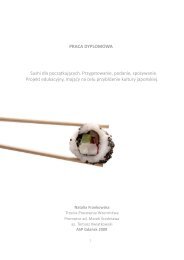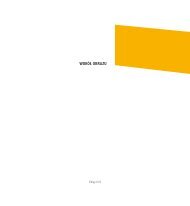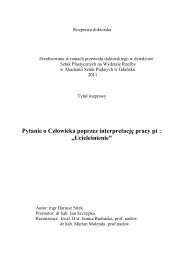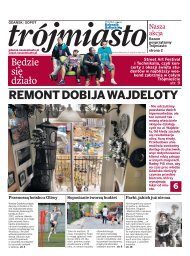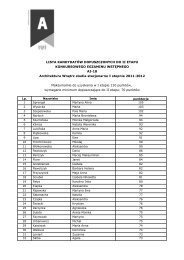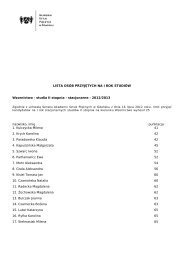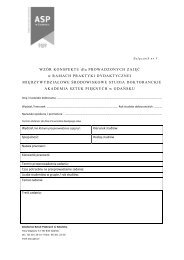katalog polskich projektów (pfd.4,7Mb) - Akademia Sztuk Pięknych ...
katalog polskich projektów (pfd.4,7Mb) - Akademia Sztuk Pięknych ...
katalog polskich projektów (pfd.4,7Mb) - Akademia Sztuk Pięknych ...
You also want an ePaper? Increase the reach of your titles
YUMPU automatically turns print PDFs into web optimized ePapers that Google loves.
in events, particularly international ones, provides a chance for them to measure themselves<br />
up to others; to compare their abilities, and sometimes to verify a chosen creative path.<br />
Among the works which have qualified there are a few designs that have already received<br />
distinctions in competitions, such as the works by Aleksandra Adamczyk, the Medusa Group<br />
and Elżbieta Piotrowska, who received awards at the last Art of Design Biennial in Kraków,<br />
or the /Water Umbrella/ by Maria Górska and Daniel Zieliński, which received 2nd prize at<br />
the International Competition in Nagoya in 2000. Some of these works have already been<br />
displayed at international exhibitions and fairs, such as the designs by Malwina Antoniszczak,<br />
Wioletta Serafin, or the puff_buff design group. Many designs are student works, mainly from<br />
the seven design faculties in Fine Arts Academies. There is no representation of the numerous<br />
emerging private schools among the exhibits. The diploma projects form a key group; some<br />
of them have already been ‘noticed’ and displayed at yearly Polish presentations, or in the<br />
columns of design magazines, or given awards, like the /Woven from Reveries and Dreams/<br />
collection by Magdalena Duraj and Barbara Szczotka, who received the Złota Nitka (Golden<br />
Thread) in this year’s edition of the most important presentation of clothing designers.<br />
Many designs, however, were carried out as course work, especially for the Saint-Étienne<br />
exhibit. These participants most often set their focus on problems faced by social ‘minorities’<br />
most often overlooked in our country, such as the handicapped, elderly or homeless, or<br />
accentuating ecological issues in their work: recycling, the exploitation of raw materials and<br />
the environment, or ‘uninvasive’ design, as in the work of Magdalena Wiśniewska-Lisak,<br />
whose armchair is shaped from growing willow branches.<br />
There is also a third group of designs which are a sort of manifesto, best characterized by Tomasz<br />
Jarosz’s commentary: How to sow the seeds of doubt in all this madness, in a system of<br />
values based on the number of zeroes in a bank account Firstly, it would be good if ‘that<br />
something’ wasn’t deadly serious. Secondly, that it should unambiguously relate to consumption.<br />
Finally, it should intrigue and be thought-provoking. / Czesława Frejlich



